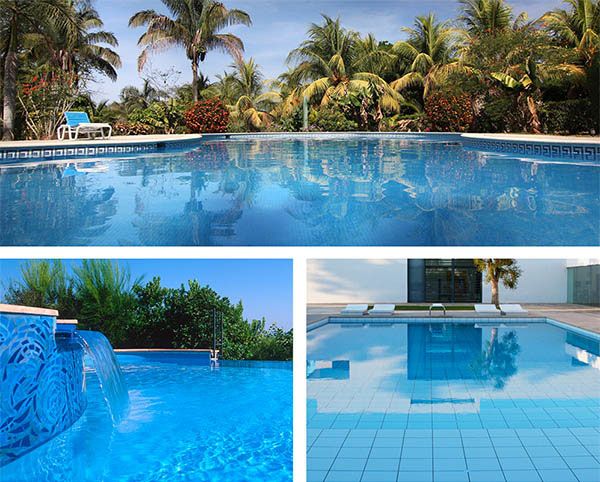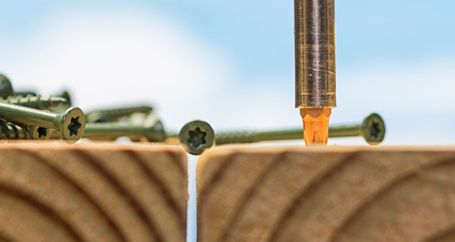"It was worth every penny and minute of upkeep to keep the family around."
— Doug Comstock, construction manager
Doug Comstock spent $50,000 building a pool and, by his account, dipped his toes in maybe 20 or 30 times over the 10 years his family lived in the home.
When he sold the Spotsylvania, Virginia, house in January 2019, he knows he didn’t come close to making back what he’d spent to build the pool.
He says he wouldn’t have it any other way.

“It was worth every penny and minute of upkeep to keep the family around — to make it the place where my kids and their friends always wanted to hang out,” says Comstock, who, from his vantage point flipping burgers at poolside, could keep a close parental eye on things. “I could see who the kids were spending time with, be with family and friends, entertain.”
But, like many pool owners, there are a few things he wishes he’d done differently during the buildout. And he had a major advantage going in: Comstock is a construction manager for one of the biggest homebuilders in the Southeast and has seen hundreds of pools installed from start to finish.
Vinyl, concrete or fiberglass? Chlorine or salt? Where to locate the pool to catch the most sun and the fewest leaves? And how much will it cost, really? Those are just of a few of the questions homeowners need to answer before breaking ground, Comstock says.
Here, pool professionals and long-time pool owners like Comstock pass along their wisdom — about deciding what kind of pool to build, how to anticipate hidden costs, and which pool features might be worth the investment or a waste of money.
Before Signing a Pool Contract

Before Signing a Pool Contract

- Meet with the person who will actually build the pool. The salesperson’s job is over once a buyer says yes. The builder can provide a road map to getting it done on time and on budget, says Stella Knieriemen, who has run her own pool construction and maintenance company in Jacksonville, Florida, for two decades.
- Consult a pool maintenance company. After Norman Salvano’s pool was fully installed in his Stamford, Connecticut, yard his pool maintenance crew volunteered an important detail: If he’d built the pool in a different place, it would get more sun and he’d also have more usable nonpool space. “I wish I’d spoken to them before building,” says Salvano.
- Investigate the license. In addition to hiring a licensed builder, it can also pay to find out who actually holds the license. Some companies operate under the license of one employee who is not an owner — a “qualifying agent.” That can lead to situations like one Knieriemen recalls: A new pool builder in Jacksonville, Florida, with no experience hired a young qualifying agent — and then disappeared, owing a million dollars to suppliers and subcontractors and leaving several fully paid homeowners with pool-less holes in their yards.
- Establish a payment schedule. As with any project, paying for all the work upfront carries the risk that the pool may never get built. Knieriemen’s company asks for a small down payment at the contract signing and set payments at benchmark stages of construction.
- Shop around. Consider the price and quality of the work but also get a sense of who the builders are. Will they be responsive if something goes wrong? Talk to their customers — and, Comstock says, not just the ones offered as references. Instead, look through municipal permit records for the company’s last five projects and talk to the homeowners, if possible.
Hidden Costs of Pool Ownership

Hidden Costs of Pool Ownership

Having seen basic pools built for as little as $30,000 and backyards transformed to the tune of $150,000, Comstock set his budget based on spending a little more upfront to avoid some of the headaches and maintenance he’d seen on the job. For example, he chose concrete instead of a vinyl liner, which can be slippery and can tear easily.
A pool company’s quote may cover only the pool, pump and filter. Everything else is extra, and expenses — as well as the time needed for maintenance — can add up. “If your pool is $50,000, you could spend another $50,000 for everything around it,” says Salvano.
Adds Bob Diliberto of Metairie, Louisiana, who already had a pool but ripped up his yard and spent $100,000 building a fancy patio around it: “It always costs more than you think it will.”
The Fence
By law, home pools must be surrounded by a code-approved, hard-to-climb fence. Costs, including installation, can range from $17 per linear foot for chain link to $24 for wood to $40–$50 for aluminum or wrought iron. Installing a fence close to the pool is less expensive, because it will require less fencing, but allows less room for poolside lounging and barbecues.
“I think a nice fence is a must because you look at it all the time,” says Salvano. “But a fancy fence comes with a fancy price. I spent $16,000 to fence in a third of the property. In the other part where I planted trees, I used a cheaper model. But that still set me back another $6,000.”
The Deck
Pool owners like Diliberto think of their pool as part of an outdoor room and go to town equipping it.
He replaced his existing patio with a bigger pool deck made from travertine, a type of limestone that stays cool in the sun but is more expensive. (Knieriemen says travertine can add $3,000 to the cost of a $10,000 deck.) He also added lighting, an awning, an outdoor kitchen and fire pits, and landscaping. “We’re out there year-round, so it’s well worth it,” he says.
Furniture also can balloon costs. “I bought a set with a table, umbrella, chairs and chaise longues for $12,000 and we didn’t even go high end,” notes Salvano. “We shopped sales.”
* Price and R O I estimates based on Remodeling magazine 2019 Cost vs. Value survey.
Heating Systems
In cooler climates, like the Northeast, water heaters can extend the summer swimming season into spring and fall. A spa/hot tub can be used even longer.
Spa/hot tub: About
$7,000–$35,0000
Spa/hot tub: About
$7,000–$35,0000
Trees
Pool owners typically hate trees anywhere near their pools. Some go as far as Bill Ciraco did: cut down the only tree in his Westhampton Beach, New York, yard so it wouldn’t foul the pool.
“You don’t want to have a messy oak tree that in June drops fronds and in the fall drops leaves and acorns,” says Ciraco. “No, that tree had to go. We have a lot of sunlight.”
Taking out trees can be costly. Salvano spent $2,500 to remove one that stood where he wanted to build his pool.

Trees
Pool owners typically hate trees anywhere near their pools. Some go as far as Bill Ciraco did: cut down the only tree in his Westhampton Beach, New York, yard so it wouldn’t foul the pool.
“You don’t want to have a messy oak tree that in June drops fronds and in the fall drops leaves and acorns,” says Ciraco. “No, that tree had to go. We have a lot of sunlight.”
Taking out trees can be costly. Salvano spent $2,500 to remove one that stood where he wanted to build his pool.

Utilities, Taxes and Insurance
A pump’s pool and heater use a lot of energy. The increase in utility bills can range widely — from $500 to $2,000 a year[1], depending on features like lighting and heat. Property taxes and homeowners’ insurance premiums also generally rise too.
Worth the Added Cost? A Bigger Filter
“The bigger the filter, the fewer chemicals you need to keep your pool clean,” says Knieriemen. A filter and pump can cost $500 to $2,000.
Pool Features Owners and Builders Aren’t So Sure About

Pool Features Owners and Builders Aren’t So Sure About

Pop-up Jet Self-Cleaning System
Water jets that pop up from the pool floor create currents to move debris toward filters — but they’re prone to breaking, can lead to leaks and are expensive to fix, Knieriemen says. “Taking a few minutes with a pool brush will clean the pool just as well with fewer headaches.”
Big, Automated Fountains and Waterfalls
Salvano has a small waterfall and likes the way it blocks out noise. “But less is more,” he says. Elaborate features can run thousands of dollars, are expensive to maintain and will need a larger pump.
Glass Tiles
Installing glass tiles along the waterline is trendy, but Knieriemen says pool owners have learned they don’t last. Concrete expands and contracts more than glass with changes in air temperature — so tiles can start popping off.
Gigantic Pools
Bigger is better, right? Not necessarily. “One of the most common laments I hear is ‘I wish I hadn’t made it so big,’” says Knieriemen. “A bigger pool means extra work and extra money — including chemicals and higher utility bills — to maintain it. And, nobody is swimming laps in it.”

Saltwater or Chlorine?
Doug Comstock’s only real regret is letting his pool salesperson talk him into chlorine disinfection instead of saltwater. Saltwater — about one-tenth the saltiness of ocean water — feels soft on the skin, is easier to maintain and carries minimal chlorine smell.
Both systems depend on chlorine to purify. Chlorine systems cost less to install but need chlorine added and acidity balanced regularly. Saltwater systems just use table salt — but require a generator to pull chlorine out of the salt, and that can cost $1,500 upfront.
“Once it’s installed, it’s much cheaper and you don’t have to deal with chemicals,” says Comstock. “If we were staying in the house another 10 years, we would’ve converted.”
Maintaining the Pool: Hire a Pro or DIY?
“I find brushing the pool walls, cleaning the filters and doing the chemicals therapeutic,” says Rob Youngberg, whose family built a pool in their Oyster Bay, New York, backyard in the 1970s. “Cleaning the pool was just part of the deal growing up. And we made a game of diving for the acorns that fell in.”
Others call in the pros. Pool maintenance companies will vacuum leaves, empty the skimmers, clean filters, chlorinate the water and balance the pH for $150 to $400 per month, depending on location, frequency and level of service. Other services may include getting the pool up and running in spring and shutting it down come fall.

The Colosseum amphiteather
in Rome is made primarily
from travertine mined from
quarries in Tivoli.
Love the Pool, but Don’t Build It for the R O I
Homeowners who add pools say they’re often asked: Was it worth it? No matter how much they love their pool, they invariably say: Don’t expect a high return on the investment.
But even if the pool doesn’t add to a home’s sale price, it can be the magic ingredient when it comes time to sell, according to Youngberg. The day before their open house, they invited friends over for one final blowout swim party.
“A couple from Queens mistakenly came early to see the house while the party was in full swing. We showed them around anyway,” Youngberg recalls. The next day, they showed the house properly to dozens of people.
But who made the winning bid? The couple from Queens: “They told us they just loved being there to see the pool party.”
THREE COMMON POOL TYPES
Florida pool builder Stella Knieriemen explains pool type basics and recommends calling two to three builders in a region before deciding which type is best suited for a home.

Vinyl-lined
Concrete, steel or polymer slabs are mounted into a steel frame. Foam and vinyl liners are fitted over them.
Cost**
$15,000-$20,000
Pros:
- The least expensive to install.
- Floor and walls are soft and flexible and can be made any shape.
Cons:
- The pool’s frame (above-ground) tops out at 10 years.
- Liners can get brittle and need replacing every five to 10 years at $5,000 a pop.
Fiberglass
Fiberglass pools are constructed off-site and shipped in one piece.
Cost**
$30,000–$45,000
Pros:
- Installation can be easier.
- More durable than vinyl.
- Less difficult and less expensive to maintain than concrete.
Cons:
- Fiberglass shell can separate from tile and decking as ground settles.
- As it ages, fiberglass threads can loosen and detach.
- Pool size is limited by what can be transported over roads.
Concrete
Concrete pools are made from various mixes of concrete and sand (gunite, shotcrete), which is sprayed over a rebar frame and often coated with plaster.
Cost**
$35,000–$50,000-plus
Pros:
- Can be built in virtually any shape, size and depth.
- Extremely durable, particularly when properly maintained.
Cons:
- Upfront and maintenance costs can be high.
- Construction can take several months.
- Needs acid-washing every five to 10 years, as necessary, to remove stains and calcium deposits.
Vinyl-lined
Concrete, steel or polymer slabs are mounted into a steel frame. Foam and vinyl liners are fitted over them.
Cost**
$15,000-$20,000
Pros:
- The least expensive to install.
- Floor and walls are soft and flexible and can be made any shape.
Cons:
- The pool’s frame (above-ground) tops out at 10 years.
- Liners can get brittle and need replacing every five to 10 years at $5,000 a pop.
Fiberglass
Fiberglass pools are constructed off-site and shipped in one piece.
Cost**
$30,000–$45,000
Pros:
- Installation can be easier.
- More durable than vinyl.
- Less difficult and less expensive to maintain than concrete.
Cons:
- Fiberglass shell can separate from tile and decking as ground settles.
- As it ages, fiberglass threads can loosen and detach.
- Pool size is limited by what can be transported over roads.
Concrete
Concrete pools are made from various mixes of concrete and sand (gunite, shotcrete), which is sprayed over a rebar frame and often coated with plaster.
Cost**
$35,000–$50,000-plus
Pros:
- Can be built in virtually any shape, size and depth.
- Extremely durable, particularly when properly maintained.
Cons:
- Upfront and maintenance costs can be high.
- Construction can take several months.
- Needs acid-washing every five to 10 years, as necessary, to remove stains and calcium deposits.
** Approximate upfront cost of a 15- by 30-foot pool.

Get a quote
Includes personal service from a Farmers agent.
Just Add Water
Swimming is the fifth most popular form of exercise and the fourth most popular recreational activity in the U.S. — American Time Survey
Written by
The information contained in this page is provided for general informational purposes only. The information is provided by Farmers and while we endeavor to keep the information up to date and correct, we make no representations or warranties of any kind, express or implied, about the completeness, accuracy, reliability, suitability or availability with respect to this article or the information, products, services or related graphics, if any, contained in this article for any purpose. The information is not meant as professional or expert advice, and any reliance you place on such information is therefore strictly at your own risk.
Related articles



